"The only reason I carry a .45 is because they don't make a .46." How often have we heard that saying? While there are now rounds like the .500 S&W Magnum (.500 bullet diameter) and the .480 Ruger (.475 bullet diameter) that are technically larger, these are powerful revolver cartridges not ideal for self-defense. Carrying them would require a substantial coat to conceal them. The classic .45 ACP remains the largest widely used self-defense round available. Curious about how it earned this status? We'll explore this and more as we dive into finding the best .45 ACP ammo.
Keep reading for the full story, or jump to the review section for my analysis on:
| Ammo | Price per round |
|---|---|
| Winchester Ranger T-Series | Out of stock |
| Speer Gold Dot Short Barrel | $1.40 |
| Federal Premium Personal Defense HST | $1.29 |
| Remington Golden Saber +P | Out of stock |
| Federal +P Tactical Bonded LE | $0.70 |
| Hornady Custom XTP | $1.55 |
| Magtech Auto FMC | $0.30 |
| American Eagle | $0.71 |
| Blazer Brass | $0.72 |
| PMC FMJ | $0.57 |
A Little Backstory
The .45 ACP was the brainchild of John Moses Browning. As discussed in my previous article on the Best .45 ACP pistol article, the Army was not happy with its .38 Long Colt service round after its poor performance against Moro insurgents during the Philippine-American War (1899-1902). The tribesmen reportedly altered their mental states (in other words, got high), wrapped themselves in grass and other vegetation for makeshift armor, and charged through the ineffective .38 Long Colt rounds to decapitate American soldiers. This situation led to the reissue of the old .45 Colt Peacemakers from storage, which effectively addressed the issue. At least, that's the narrative I've always understood.
While the real events might not have been as dramatic, the .38 caliber round proved inadequate. Consequently, Army Ordnance General John Thompson (noted for the Tommy gun) and Major Louis LeGarde of the Medical Corps conducted ballistic tests to assess the effectiveness of various projectiles. They used different types of test media, including live animals. The outcome of these tests led the General to recommend a service round of “no less than .45 caliber” with a full-metal-jacketed (FMJ) bullet, fired from a semi-automatic pistol rather than a revolver, which was quite forward-thinking for 1904.
Enter Mr. Browning's New Gun
John Browning had been working on a .41-caliber round but quickly shifted his focus to develop a self-loading .45-caliber pistol and a corresponding rimless cartridge. He chose a 230-grain FMJ round-nose bullet traveling at approximately 830 fps and then created the now-iconic M1911 to fire it. Trials were conducted in 1906, and as history shows, the M1911 was the chosen design. Adopted in 1911 (hence the name), the M1911 served from 1911 until 1986, with some special-ops units still using it today. Many gun enthusiasts consider the 1911 to be the finest battle pistol ever designed.

One of the most renowned and outspoken advocates of the .45 ACP was Col. Jeff Cooper, a very famous gun writer, firearms instructor, and expert in handguns and rifles. His writings were both scholarly and practical, grounded in extensive experience. Cooper's legacy endures at the Gunsite Academy, originally founded as the American Pistol Institute in 1976. He pioneered the “modern technique” of pistolcraft, including the two-handed Weaver stance that aligns the sights with the shooter’s eye, among other techniques. Cooper’s preferred weapon was the 1911, and his endorsement played a significant role in maintaining the popularity of the .45 ACP. This cartridge is now available in many pistols and several carbines. Over the years, I’ve owned multiple 1911s and other .45 ACP pistols, and my current .45 ACP sidearm is a Springfield Armory XD(M). You can read about my experiences with the Springfield Armory XD(M).
A Quick History Lesson
We often think of the military-issue .45 ACP bullet as being 230 grains, but the original bullet that passed the Thompson-LeGarde tests was actually 200 grains. It was only after further discussions and adjustments that the 230-grain standard was established. Initially, the .45 ACP cartridge used a small pistol primer. However, when the Frankfort Arsenal began producing the round, they used a “mid-size” primer since they manufactured their own primers. Eventually, the decision was made to standardize on the large pistol primer to avoid any confusion. Despite this, there are still several factory-loaded rounds with small-pistol primers available today that perform reliably.

Two Basic Bullet Types
Today, the .45 ACP is available in two primary bullet types. The 230-grain FMJ round-nose bullet (or its cast equivalent) is commonly used for practice, target shooting, and competition. For self-defense, there are various more specialized bullet types, with the jacketed hollow point (JHP) being the most prominent, available in weights ranging from 165 to 230 grains. While these are the main types commonly discussed, it's important to note that the .45 ACP's ammo selection is broader than just these examples. There is now a wider array of .45 ACP ammunition than ever before in its extensive history.
Popular...But Not Like The 9mm
While the .45 ACP isn't as popular as the 9mm for self-defense, it has proven its enduring appeal and continues to have a dedicated following. Many older shooters, who may have more experience with the .45 compared to other common self-defense rounds like the 9mm or .40 S&W, still favor it. When I began carrying a concealed weapon forty years ago and was looking for an autoloader, the 9mm had not yet gained widespread popularity. At that time, the .45 was a primary option alongside the .380 or .32. It was typically used in a 1911, as double-action .45s were rare and often less reliable.
This isn’t to suggest that younger shooters aren’t interested in the .45; however, it seems that older enthusiasts are more vocal and protective of the round compared to the newer generations who may be more familiar with the 9mm for carry use.
A testament to the .45 ACP’s longevity is its revival of sorts. Although it has never truly disappeared, recent advancements in bullet technology have increased its popularity more than ever. As mentioned, the 9mm remains more popular than the .45 for several reasonsU
- Weight: 9mm ammo is lighter and smaller, so more rounds can be carried in magazines. This leads to:
- Capacity: The highest-capacity 9mm I know of is the Tanfoglio (EAA) Witness Match and Springfield XD pistols with their 19+1 capability. The highest-capacity .45 ACP guns that I know of are the Remington RP-45 and FN FNX pistols, which hold 15+1. (There are probably more examples of each type out there but these are what I could think of off the top of my head). The weight difference isn't great, but with 19 115-grain rounds in the 9mm's magazine compared with 15 200-grain rounds in the .45 ACP's, you will notice it.
- Cost: 9mm is usually cheaper than .45 ACP, if you compare similar types of ammo. Notice I said "usually" ...specialized ammo for either caliber can be expensive.
- Availability: I have seen more boxes of 9mm ammo in local shops than .45 ACP. This is not a hard-and-fast rule, but is something that I've noticed over the past few years. 9mm is cheaper to stock, since dealer cost is usually less than corresponding .45 ammo.
So, where does that leave us? I felt it was important to compare the two calibers, given that both are popular, though the 9mm currently leads in gun and ammo sales. Does this make the venerable .45 any less effective as a self-defense round? Not at all. There's an old saying that goes something like, “The .45 starts out at the diameter that the 9mm needs to expand to in order to be effective.” Now, don’t misunderstand me—I don’t believe the 9mm is lacking in “stopping power,” whatever that may mean. Modern ammunition has demonstrated through various tests that the three major self-defense autoloader calibers—the 9mm, .40 S&W, and .45 ACP—are statistically comparable in terms of incapacitation ability, provided the bullets and velocities are appropriate.
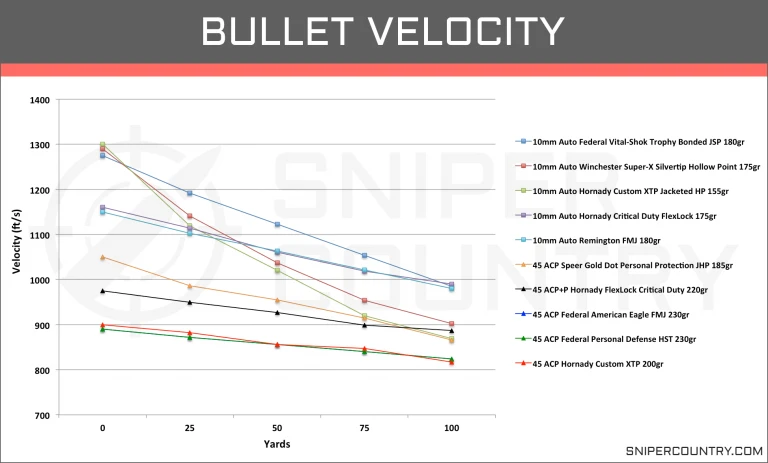
The only reason I brought that up is because it’s a frequently heard sentiment. There are numerous .45 enthusiasts, myself included. I’m merely highlighting that while the classic .45 ACP has its merits, it isn’t the only option available for self-defense.
Popular Articles
Ammo Choices
So, what type of ammo should we use? It depends on the purpose. For general practice, target shooting, and competition, a cast or jacketed round-nose or semi-wadcutter bullet works well and is more cost-effective compared to jacketed hollow points (JHP) or other self-defense rounds. However, for your carry gun, you should load it with JHPs after practice. These bullets are more suitable for self-defense than full metal jacketed bullets. This creates a bit of a dilemma, as it's ideal to practice with the same ammunition you carry. But there are strategies to address this issue, which we’ll explore later.
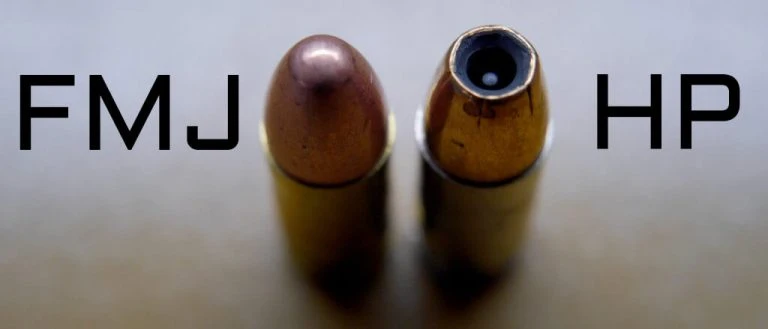
Full Metal Jacket
As mentioned earlier, FMJ stands for full metal jacket. This type of bullet is fully encased in a copper jacket, except possibly for the base, which might be left exposed. The jacket completely surrounds the lead core, preventing it from coming into contact with the gun barrel’s rifling. For many years, the military favored FMJ bullets because they fed more reliably in fully automatic weapons, where exposed-lead bullets could cause jams. In civilian contexts, .45 ACP FMJ bullets are best suited for practice, target shooting, and competitions rather than self-defense.
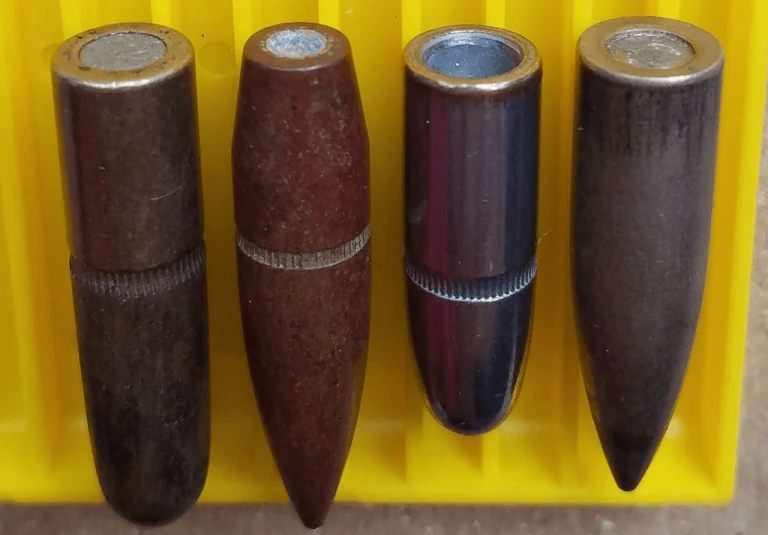
Photo: Thewellman
Jacketed Hollow Point
The jacketed hollow point (JHP) is the type of bullet most suited for defensive use. It features a lead core encased in a copper (or other metal) jacket, similar to an FMJ bullet, but with the key difference that the nose of the bullet is left uncovered, exposing the soft lead. This design allows the bullet to expand upon impact, with the jacket and core splitting and peeling back like flower petals.
This expansion increases the bullet’s diameter, creating a larger wound channel. However, in real-world scenarios, several factors can affect the JHP’s performance compared to tests on ballistic gel blocks. For instance, if the bullet encounters a thick coat or heavy garment, strikes a major bone, or is deflected upon entry, it may not expand as intended or achieve its full penetration potential. Despite these variables, JHP ammunition remains the recommended choice for self-defense.
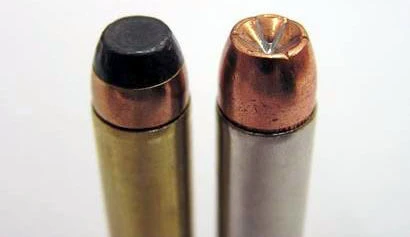
Photo: ReconTanto
So What Self-Defense Ammo Do I Buy?
Alright, you’ve just purchased a box of practice FMJ ammo. Since FMJ ammo isn’t as critical as JHP for self-defense, you’re now looking to buy a carry load that uses JHP bullets. What’s the next step? Start by experimenting—buy a box or two of different JHP rounds, as each of the rounds discussed here has been proven effective and could serve as excellent carry ammo. You might wonder, “Why buy two or three different boxes? Ammo is expensive!” It’s true, but if you only buy one type of ammo, you might not fully discover the best option for your carry needs.
By trying two or three different loads, you increase the chance of finding one that offers better accuracy or reliability than the first option. Testing multiple types improves your odds of discovering a load that consistently performs well, such as one that delivers tight groups and reliable feeding. That could be your ideal carry load.
Try To Match The Bullet Weights...Two Reasons
When selecting both practice and carry ammo, there are a couple of important considerations. Firstly, try to match the bullet weights between your practice and self-defense ammo, or at least get close. For instance, if your tests show that a 230-grain JHP bullet performs best, then choose 230-grain FMJ practice ammo. Matching bullet weights is beneficial for two main reasons.
BONUS OFFER: Get your free shooting range targets to print at home!
Get your free targets to print at home!
Reason One
Matching bullet weights ensures that the recoil between practice and carry rounds is similar. I didn’t say they will be identical, as self-defense ammo is generally loaded hotter than FMJ rounds and will likely produce more recoil.
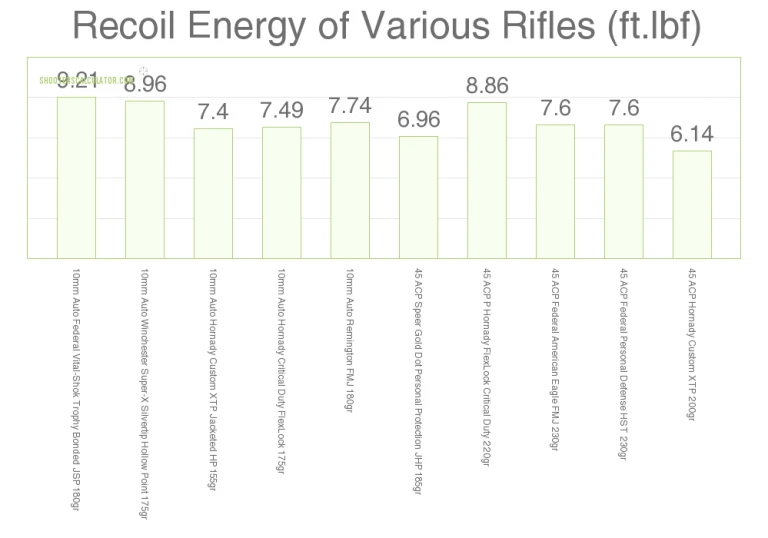
It's preferable to use the same bullet weight for both your practice and carry ammo rather than practicing with, say, 230-grain FMJ and carrying 185-grain self-defense ammo. Although the recoil will be somewhat similar, you might end up adjusting to two different recoil impulses, which can disrupt the consistency of your muscle memory. For instance, your ability to quickly reacquire your sights after a shot might be affected. While the difference might not be significant, those who practice with a timer to refine their skills or for competition could find that even a fraction of a second matters.
If you carry 185-grain JHPs, practicing with a similar-weight 200-grain semi-wadcutter or round-nose load should provide comparable recoil. However, the shift from 230 to 185 grains can introduce slight variations in recoil. To maintain consistency, aim to use the same bullet weight—or one as close as possible—for both practice and self-defense ammunition.
Reason Two
The second reason for using the same bullet weight for both practice and carry ammo is related to sight adjustment. Ideally, a 230-grain bullet should impact the target in roughly the same spot as another similarly-loaded 230-grain bullet, regardless of type. However, if one 230-grain bullet travels at 820 fps and another at over 900 fps, the point of impact will likely differ, even if only slightly. If your firearm has an adjustable rear sight, you can set it for your carry load and leave it unchanged. In this case, any variance in impact between practice and carry loads will be less of a concern. If your practice ammo hits “two inches down and three inches right” from where your carry ammo prints, it won’t matter much if you are focusing on practicing self-defense skills with your carry ammo.
Practice ammo should be a tool to enhance your skills, not the ultimate goal. If your gun doesn’t have an adjustable rear sight or only has drift-adjustable windage, ideally, the point of impact for the two loads should be close enough that it doesn’t create significant issues. However, there is one more factor to consider that might affect your shooting.
Bullets Hit Lower On The Target -- Why?
Self-defense loads are often loaded hotter than standard FMJ ammo, sometimes even labeled as +P. When bullets are fired at higher speeds, they typically strike lower on the target. This happens because the faster bullet exits the barrel before the barrel has a chance to rise significantly in recoil, compared to a slower load. Is this a major concern? No if you understand the dynamics and have your sights properly adjusted for your carry load. Typically, your practice ammo will hit slightly higher on the target compared to your carry ammo.
It’s important to remember this and adjust your approach accordingly. I used to adjust my sights for both types of ammo, trying to "chase the holes" on the target. Instead, the key is to practice extensively with both loads to identify any quirks or differences in performance. Now, let’s examine ten different .45 ACP loads—three for practice and seven for carry.
+P Ammunition
You might be curious about the +P label on some ammunition. This designation indicates overpressure ammunition—cartridges loaded with a higher amount of gunpowder, which increases the velocity and power without requiring a new gun or a larger cartridge size. However, increased power also means more recoil, which can be uncomfortable in smaller handguns.
It’s important to use +P ammo only in firearms that are specifically rated for it. Using +P ammunition in guns not designed for it can potentially damage the firearm and pose a risk of injury. Always check your firearm’s specifications before using +P ammo.
How To Know If a Gun Is Built for +P?
Check your gun’s manual to see if it is rated for +P ammo. If you don’t have the manual, consult a gun dealer or gunsmith—they can provide you with the necessary information.
Congratulations on digesting all that information about .45 ACP ammo! Now, let's dive into the best .45 ACP ammunition available today.
Our Picks for Best .45 ACP Ammo
In this review I cover:
| Ammo | Type | Penetration | Expansion | Muzzle Velocity (fps) | Weight (gr) |
|---|---|---|---|---|---|
| Winchester Ranger T-Series | JHP | 14.2" | 1.010" | 885 | 230 |
| Speer Gold Dot Short Barrel | JHP | 12.9" | 0.707" | 820 | 230 |
| Federal Premium Personal Defense HST | JHP | 14" | 0.84" | 890 | 230 |
| Remington Golden Saber +P | JHP | 15.7" | 0.758" | 1140 | 185 |
| Federal +P Tactical Bonded LE | JHP | 14.7" | 0.842" | 950 | 230 |
| Hornady Custom XTP | JHP | 18.1" | 0.56" | 900 | 200 |
| Magtech Auto FMC | JHP | 15.1" | 0.771" | 837 | 230 |
| American Eagle | FMJ | - | - | 890 | 230 |
| Blazer Brass | FMJ | - | - | 830 | 230 |
| PMC FMJ | FMJ | - | - | 830 | 230 |
Winchester Ranger T-Series 230 grain
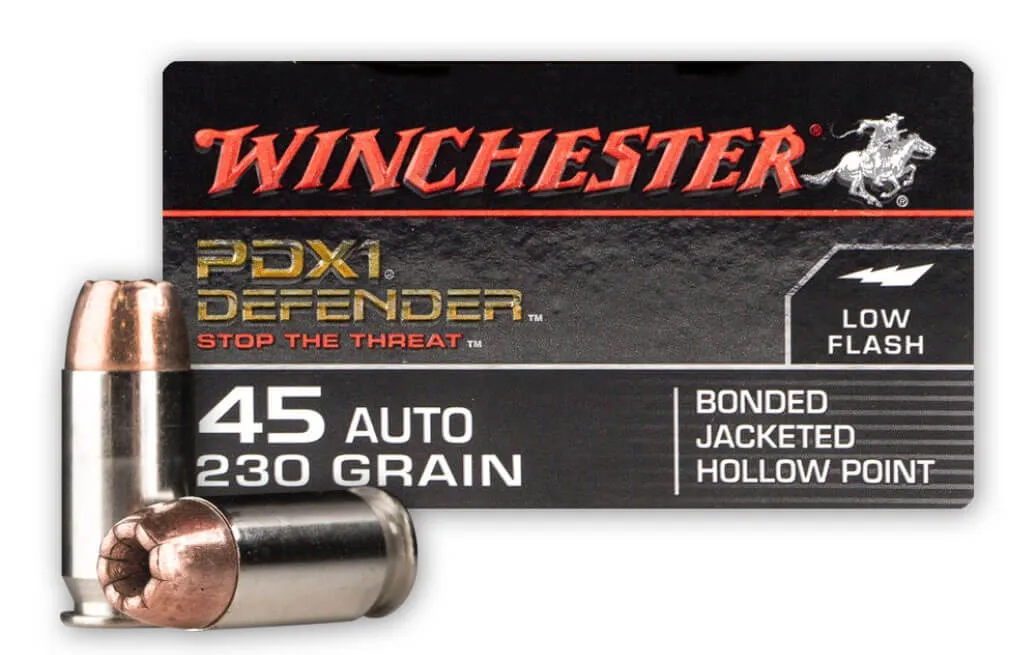
Winchester has been a trusted brand for law enforcement for over a century, known for its quality and high-performance ammunition. Their products, including the Ranger T-Series, are recognized for impressive expansion and velocity.
The Ranger T-Series is among their top-performing loads. It features a modified SXT bullet with a brass primer cup and nickel-plated brass casings. The bullet has a reverse taper jacket with serrations that form six petals, and the base of the lead core is exposed. With a velocity of 935 feet per second (fps), an average penetration of 14.2 inches, and a consistent expansion of 1.010 inches, it’s well-suited for both personal defense and tactical applications.
- High-end performance
- Consistent expansion
- Proven reliability for years
- Expensive
Speer Gold Dot Short Barrel 230 grain
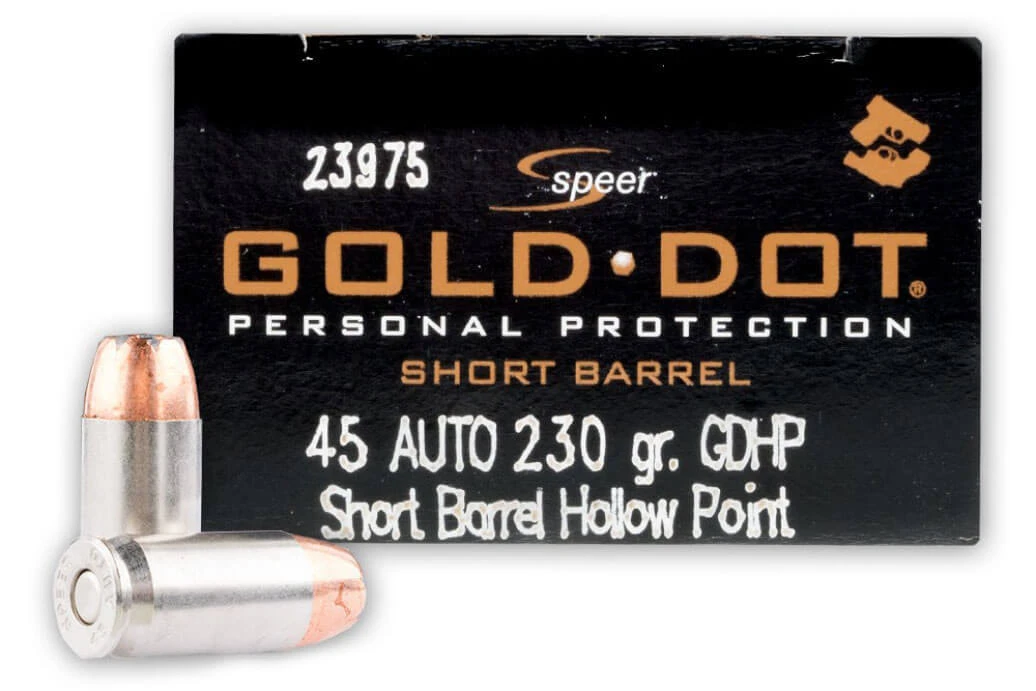
The Speer Gold Dot has proven to be a reliable choice for both self-defense and service applications, and it is widely used by law enforcement. Its design includes a hollow-point cavity filled with elastomers and reinforcing ribs to support the petals. The bullets are chemically bonded, ensuring excellent weight retention and accuracy.
With a velocity of 820 feet per second (fps) and an average penetration of 12 inches, it provides effective self-defense performance. It also features a consistent expansion of about .707 inches. The "Short Barrel" designation indicates that this ammo performs well in barrels as short as 1.9 inches, making it an excellent choice for those using subcompact .45 firearms.
- Proven reliability for self-defense
- Can work well in guns with short barrels
- Low penetration
Federal Premium HST Personal Defense 230 grain
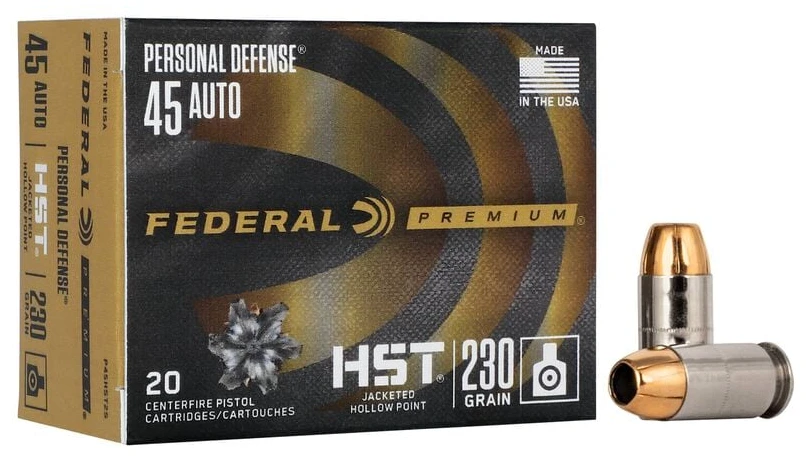
Like Winchester, Federal is a leading name in firearms and ammunition. Federal designed this ammo for maximum expansion, and it’s also utilized by various law enforcement agencies in the U.S. Although the bullets aren’t bonded, the ammunition is still well-crafted and performs effectively even in shorter barrels. It has a velocity of 890 feet per second (fps), an average penetration of 14 inches, and a consistent expansion of .84 inches.
The Federal Premium HST Personal Defense ammo features a pre-skived tip, which helps the bullet expand into large petals and creates a significant permanent wound cavity. Unlike standard rounds, this design reduces the risk of bullets becoming "plugged" when penetrating barriers, enhancing its reliability in various defensive situations.
- Great expansion and penetration
- Design that prevents bullets getting plugged
- Unbonded bullet design
Remington Golden Saber +P 185 grain

Remington's ammunition features a bonded core and jacket for optimal performance. The copper alloy jacket includes deep serrations that facilitate reliable expansion. With added pressure, the rounds achieve a velocity of around 1,150 feet per second (fps) from a standard 5-inch barrel. They offer an average penetration of 15.7 inches and consistent expansion of 0.76 inches. Designed for both self-defense and light hunting, these lightweight rounds are tailored for effectiveness in a range of situations.
- Lightweight and delivers high velocity
- Great penetration and expansion
- +P might give more recoil
- Can only be used for guns built to withstand +P ammo
Federal Premium LE +P Tactical Bonded HP 230 grain

The +P feature of the Federal Premium LE ammunition provides an impressive velocity of 950 feet per second (fps). Designed specifically for law enforcement, this .45 caliber round can create an exit wound of .842 inches and offers an average penetration of 14.1 inches. The bullets are constructed with a bonded hollow point design to ensure excellent weight retention. Additionally, the nickel-plated brass cases are boxer-primed and reloadable. Despite the +P rating, the increased velocity remains manageable, delivering strong expansion and penetration.
- Nickel-plated brass allows better reload
- Bonded bullets for weight retention
- +P gives more recoil
- Can only use guns built to withstand +P ammo
Hornady Custom XTP 200 grain
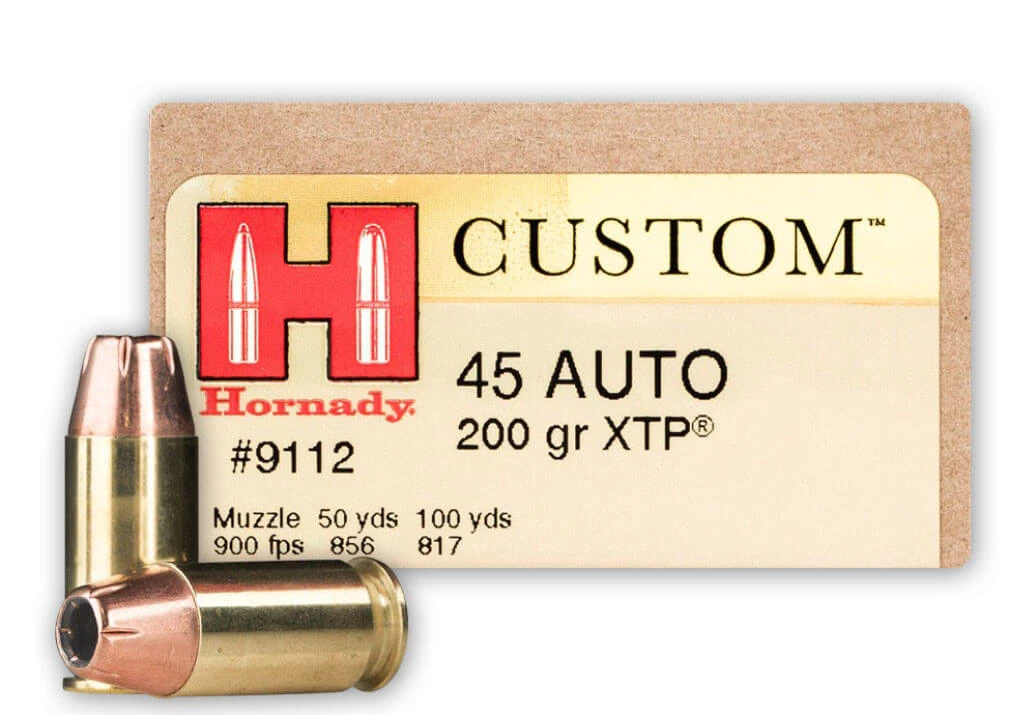
The Hornady Custom .45 ACP is a high-quality round for self-defense, offering great performance at a more affordable price compared to other premium options. The XTP bullet features a swaged lead core for nearly perfect balance and stability, with small serrations that weaken the copper jacket to ensure reliable expansion even at lower velocities. While its brass cases aren't as optimal for reloading as nickel-plated ones, they remain reloadable. This round excels in penetration, averaging 18.1 inches, which surpasses the standard, and provides an average expansion of 0.56 inches. The Hornady Custom .45 ACP also benefits from its lighter bullet weight, achieving a higher velocity of 900 feet per second (fps).
- Great accuracy
- Consistent expansion
- High penetration (above the 18-inch range standard)
Magtech .45 Auto 230 grain
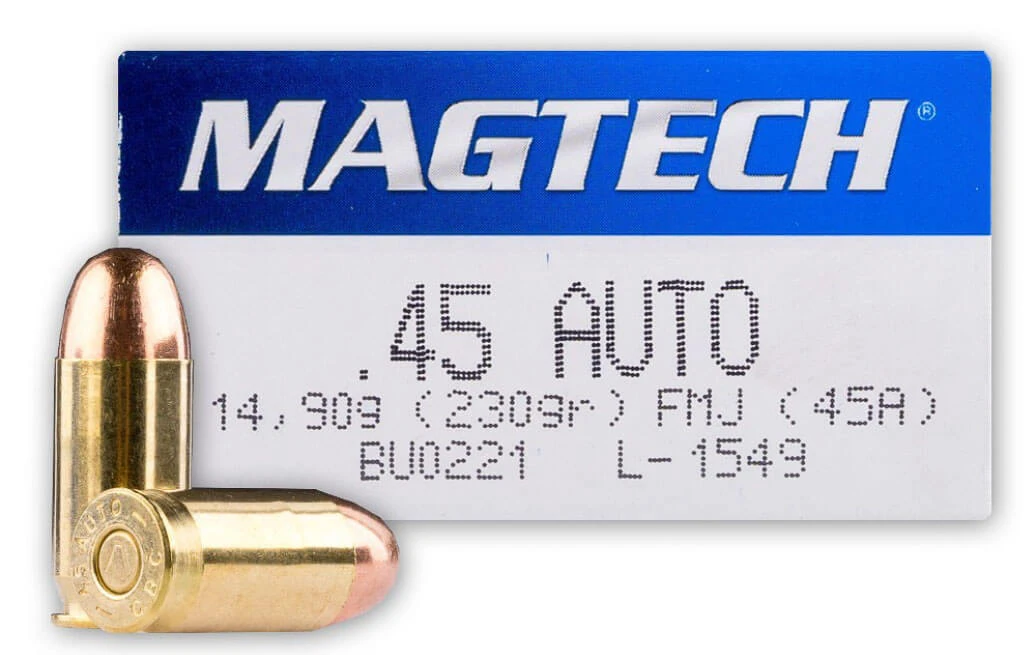
Magtech is a prominent brand under CBC Global Ammunition, a major corporation that produces billions of rounds annually across multiple global facilities. This company supplies ammunition to NATO and various military forces, and Sellier & Bellot is also part of its portfolio. Known for its exceptional quality and affordability, Magtech has earned a solid reputation in the U.S.
Magtech ammunition, particularly the Auto FMC, is ideal for recreational shooting and is especially suited for newcomers due to its cost-effectiveness. The Auto FMC delivers a muzzle velocity of 837 feet per second (fps), offers an average penetration of 15.1 inches, and provides an expansion of 0.771 inches. For its price, Magtech is a great value.
- Made in high quality
- Great for target shooting
- Price is cheaper only when purchased in bulk
Federal American Eagle 230 grain
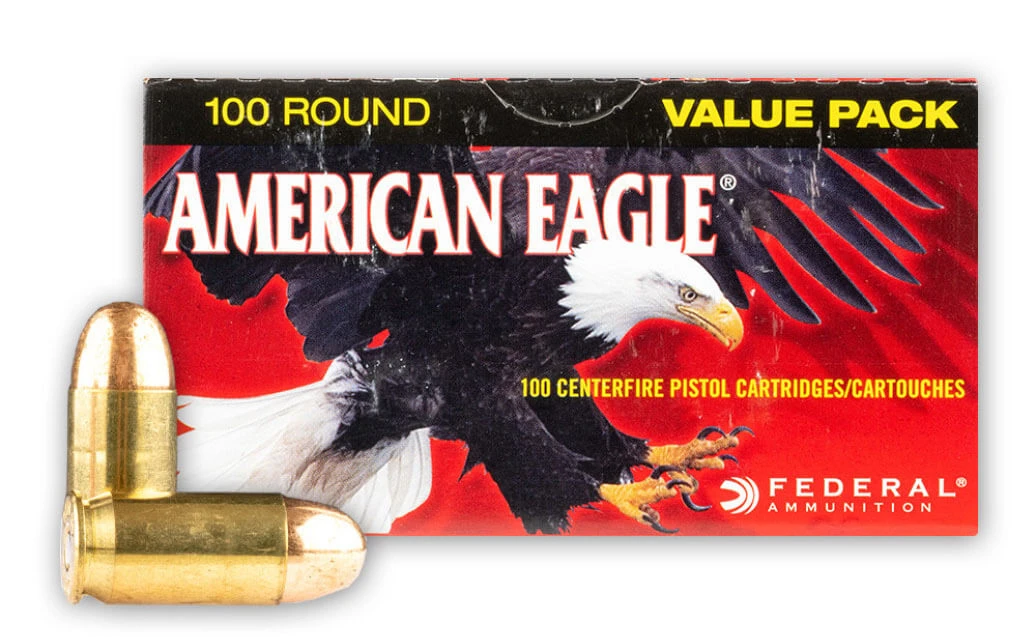
American Eagle, a brand from Federal Premium, is one of the most recognized names in ammunition. It's widely available and offers a good balance of performance and affordability. With a muzzle velocity of 890 feet per second (fps), it provides comparable velocity to some higher-end rounds, making it a solid choice for target practice. This midrange product is also reloadable, making it a practical option for regular shooting.
- Easy to find
- Affordable
- Great to use in range shooting
- Muzzle velocity of 890 fps is middle of the pack
Blazer Brass 230 grain
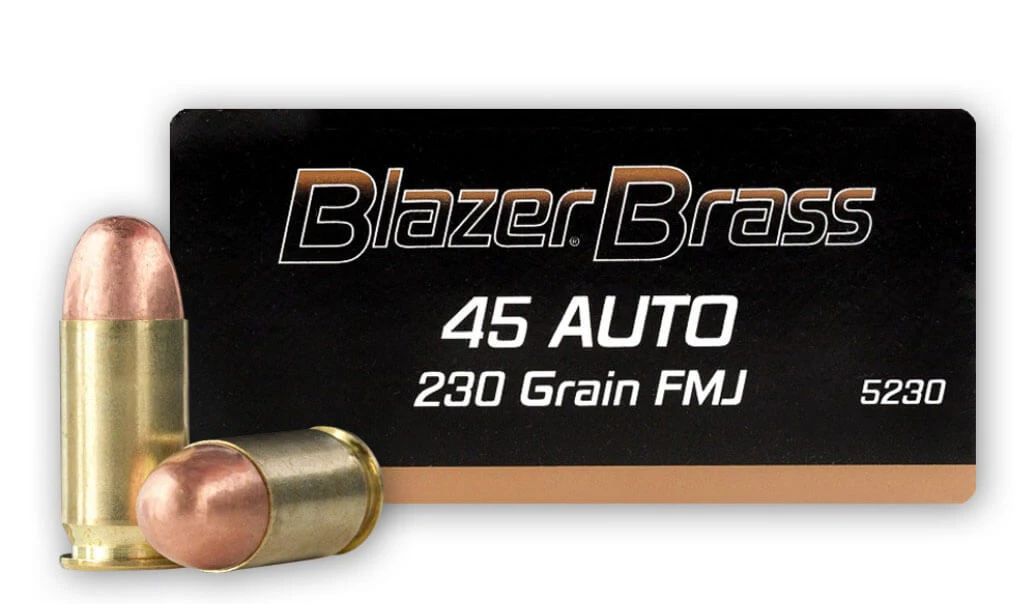
Blazer Brass offers some of the most affordable ammunition available, making it an excellent choice for recreational shooting, target practice, and tactical training. It comes in brass cases, is boxer-primed, and is reloadable. However, it’s important to note that Blazer Brass .45 ACP uses small pistol primers instead of the standard large pistol primers used in most .45 ACP rounds.
- Reliable and affordable
- Great for range shooting
- Uses smaller-than-average pistol primers
PMC Bronze Ammunition 230 grain
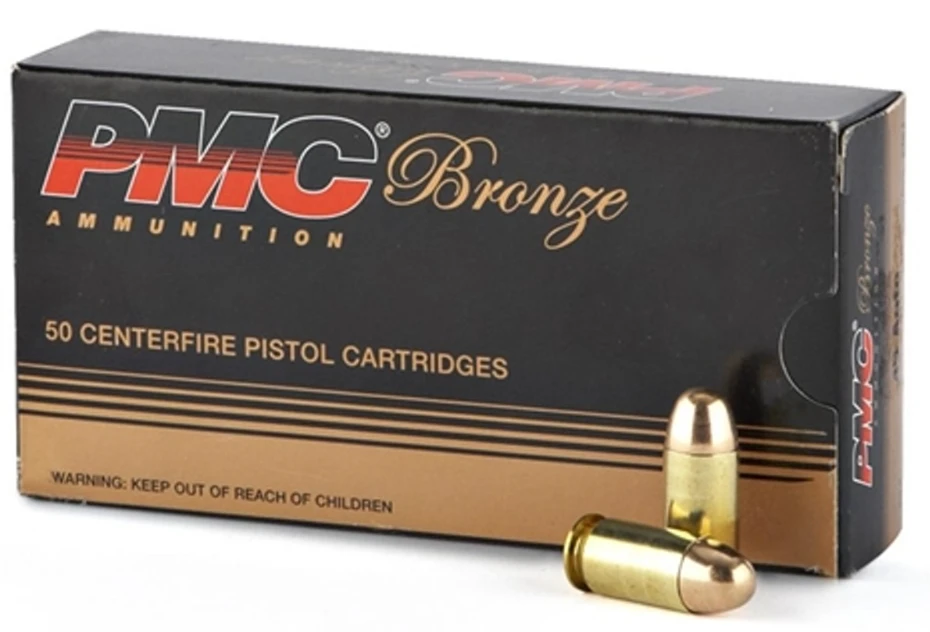
PMC ammunition is even more affordable than Blazer Brass and remains a solid choice. Constructed from brass, it serves as a reliable alternative to steel-cased options. Its low cost makes it particularly suitable for range shooting and practice.
- Reliable and affordable
- Great for range shooting
- Occasional misfeeds
Conclusions
So, what's the takeaway from all this? Deciding which rounds to use for carry or practice depends on several factors, including your specific firearm and personal preferences. There might be better loadings available, and it's crucial to determine if these cartridges will function reliably in your three-inch General’s Model Colt 1911.
These are questions that can't be fully answered in a single article. The best approach is to buy various loads and test them in your own gun(s). If you can only purchase one box at a time, start with that. Evaluate its performance, and when possible, try a different load next. Once you've either found a load that works exceptionally well for your .45 or you've tested a few options from our list to find the ideal carry round, you can make an informed decision.
- Buy as much of it as you can, but only if you're SURE that this is the best load for your gun.
- Once dialed in and you've determined the load is the one you want to keep, explore buying it in quantity. Unless you have a favorite online supplier, start with well-known sites such as LuckyGunner, Midwayusa, or similar enterprise. You should be able to lower, even if it's by only a small amount, the price per round by buying 500 or 1000 rounds at a time. This system should be applied to both practice and carry ammo.
- OK...you've got your perfect ammo. Now what? Shoot it, of course! Practice, practice, practice. That's the only way to prove to yourself that the ammo truly works, and to prove to yourself your own shooting skills are improving.
If you’re curious about the expansion or penetration characteristics of your ammunition, set up some water-filled milk jugs at your range, if allowed. Shooting them will give you a practical sense of how the ammo performs in terms of expansion and penetration.
1. Terminal Milk Jug Ballistics -- Milk jugs aren’t a perfect stand-in for human tissue, but they can give you a basic understanding of your ammo’s expansion and penetration in a water-based medium. Many ranges might not allow this kind of testing, so you might need to visit a friend’s farm or find a secluded pasture for your experiments. At the very least, make sure to check the accuracy of your load—if you can’t hit your target, even the best ammunition won’t be effective.
2. Sight Adjustments -- Ensure that your ammunition hits where you aim. Make sure to sight in for your carry load and keep those settings unchanged. Your practice load is just for training, so focus on memorizing the hold needed to hit accurately with it.
Enjoy the selection process—although it can be pricey, it’s also the fun part of choosing your practice and carry ammunition. Feel free to share in the comments below if you find the perfect ammo!






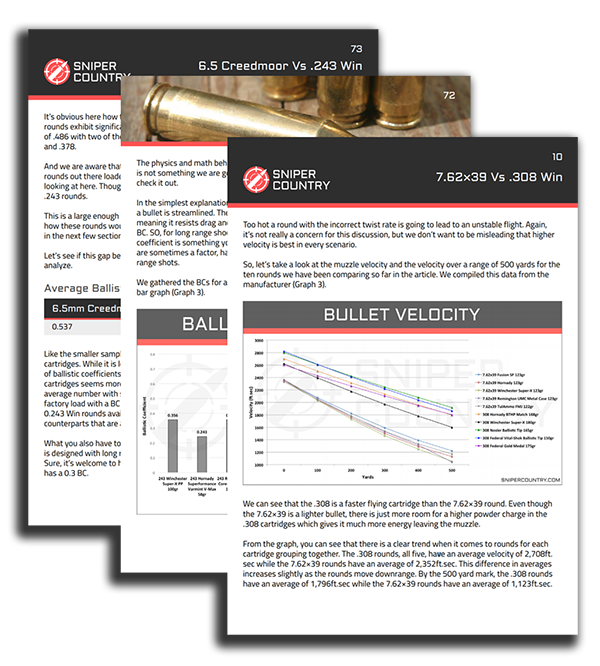


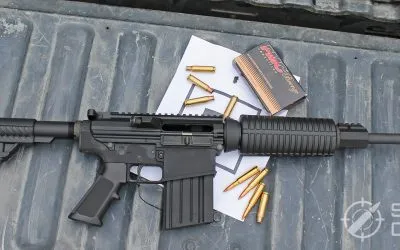
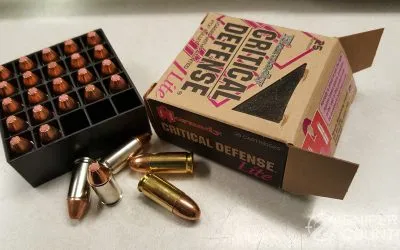
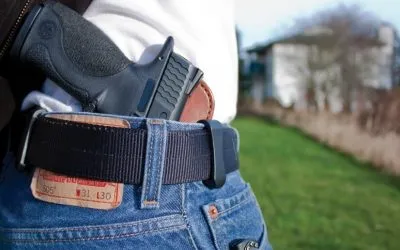
![9mm Glock Models [Ultimate Guide]](https://snipercountry.com/wp-content/uploads/2018/10/Glock-17-vs-Glock-19-vs-Glock-26-vs-Glock-41-vs-Glock-43-WM-400x250.webp)
![Handgun Caliber Chart [2025 Ultimate Guide]](https://snipercountry.com/wp-content/uploads/2018/10/Handgun-Caliber-Comparison-400x250.webp)
![Rifle Calibers [Ultimate Guide]](https://snipercountry.com/wp-content/uploads/2018/12/Header-1900-400x250.webp)





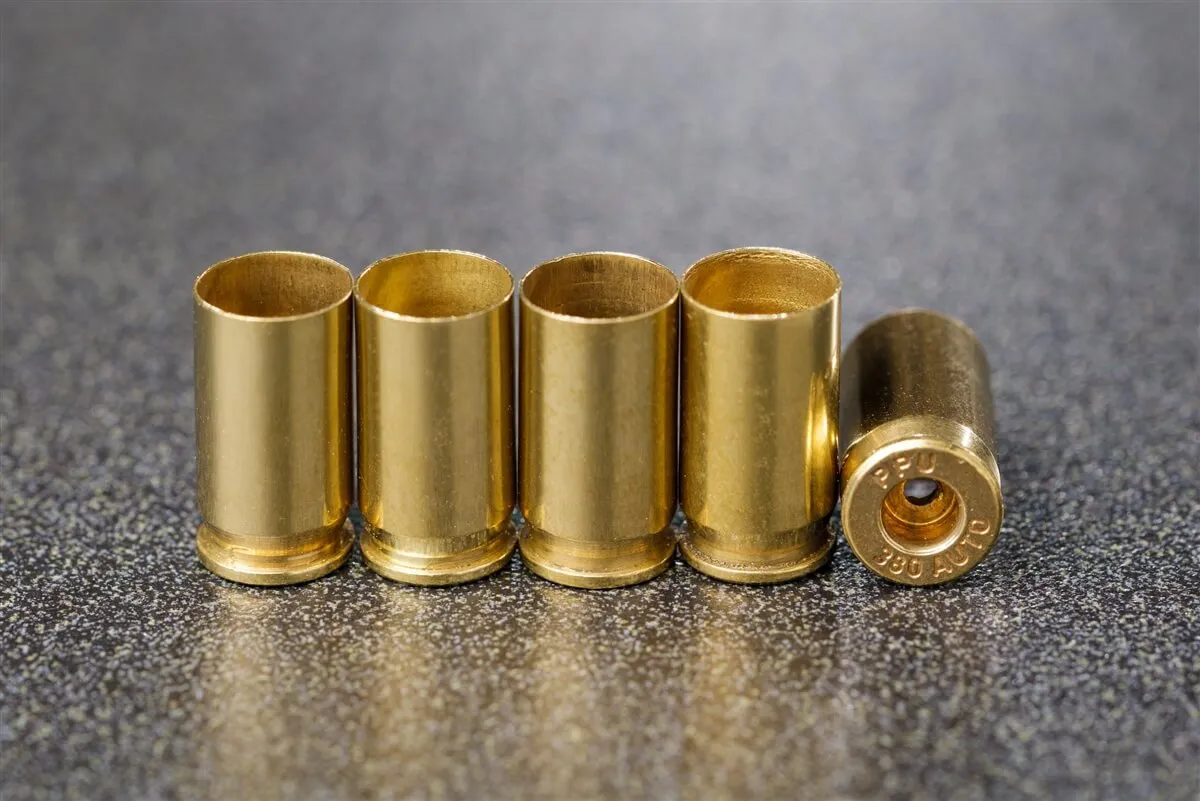


45 Responses
Great article. Thank you. Anything similar for 9mm? You knew that was coming!!
There you go Jim:
Best 9mm Ammo 2019
This is really a great article that’s extremely informative for the newcomer to the .45 life. The only thing I wish y’all would have addressed when it comes to the ballistic tests was how well the different rounds were affected by having to penetrate material before the ballistic gel first. Many of the JHP rounds in this article are known to clog up and not expand sometimes when penetrating jean material or heavy coats. My personal favorite 45 acp ammo is the Xtreme Defender +P by Underwood Ammo. This stuff is truly barrier blind and amazing.
Jose, yeah, that can be a problem. That’s why some guys who do gel tests lay denim over the gel, to get a more real-world result. For an interesting take on ballistic tests, check out Paul Harrell’s YouTube videos. They are really interesting. Underwood ammo is some of the best ,and hottest, you can buy. Good choice! Thanks for writing.
I love the 45apc only reason I went with 40 cal was it held 15 rounds and at that time they did not make a 45 that had that many rounds one I am looking at is FNH tactical 45 5inch barrel big I know but I can fit it on me fine I carry one magazine in gun and two spare in pockets and in my walker 6 more LOL
…so you’re ready for the zombies! That’s more ammo than some small stores have! My saying is it’s better to have it and not need it than to need it and not have it. Thanks for writing!
Where does the 1905 Colt 45acp fit into the story?
Steve, the 1905 Colt was John Browning’s original .45 ACP. It worked…it was the first commercially-sold 45 ACP and used the familiar short-recoil tiliting-link action. It’s just that the military wanted some different options after its experiences during the pistol trials in 1906, so the 1905 was continually updated until it morphed into the 1911, which won the military contract. Interestingly, the 1905 was sold until 1917 when the parts ran out. Great question…made me do more research! Always a good thing. Thanks for writing!
Really enjoyed the article ! I also LOVE the 45 acp !
Great! At least we’re not the only ones! It’s a great round. Thanks for writing!
Nicely written article, informative and useful guide to ammo for. 45 acp. Although not as popular as the 9mm an amazingly effective round. Always my choice of carry round closely followed by the 10mm.
The 10mm would be an amazing self-defense round if you can handle the bounce and blast, especially in a shorter-barreled gun. It is a great hunting round, as well. But…there will always be the .45! It’s 108 years old and counting. Thanks for writing!
The best article on 45ACP ammo I have read. Great job. From former California Deputy Sheriff, Navy Investigator and lifetime handgun shooter.
Wow! Thanks for the compliment! Bob, first, thanks for your service and secondly, you made my day! I always really appreciate expert opinions. Thanks for writing!
Recoil Energy of various rifles? Mislabel on the graph. Good article. I use Remington Ultimate Defense 230 grain JHP rounds, and everyone has their preferences – but articles like this add fuel to the fire and encourage experimentation, which is good – both practically and economically. Thanks.
Regarding the recoil graph, we used shooterscalculator.com for that. For some reason they always use “rifles” for the heading.
If you take the Remington rp45 and put a base plate from a para p14 on the magazine it becomes a 17 + 1
James, good point – thanks for sharing that!
Thanks for a great knowledge providing article Mike. Am I missing something in picking my defense round by the ft lbs energy table, I.e. picking the Winchester at the highest energy round?
Rick, as long as the round functions every time in your gun and is accurate, there’s nothing wrong with looking at energy tables. Just remember that energy is only one of the factors you should use to choose your carry ammo, with those other points entering into it as well. Reliability is paramount. I’d rather have to use FMJ ammo if hollow points won’t function in my gun – please run all loads through your gun a lot to judge reliability and accuracy before settling on any load. Thanks for writing!
Good, solid information. My personal preference is to use 230 grain loads in my 1911’s and the 185 grain load in my polymers.
I must be out-of-phase somehow. I was all in on the 9mm years ago, but found my way back to the .45 ACP. (And .357Magnum)
Dan, nothing at all wrong with the old war horse! The .45 and .357 are still effective self defense rounds, given the right loads. Thanks for writing!
This very Informative publication is more than useful . Since many “Shooters” know the complexity involved between the right ammo & the right gun , the majority do not . Many are oblivious to modern-day ballistics , and rely on “Caliber” as the definitive factor . In other-words , I’m sure we’ve all heard people say , “Hey , this is a .45 and it’ll kill you no-matter where it hit’s you” !
This is an excellent Post , and it gets to the point .
WELL DONE !!
Alexander, thanks for the kind words. I’m just trying to take some of the things I’ve learned over 40 years of shooting and sharing them. I am a .45 fan, but I also know that some of the newer 9mm loadings are statistically just about as effective as the old war horse in a self-defense scenario. I appreciate your comments!
I am new to guns, and looking for knowledge about them. Im in my late 50s and enjoys shooting my 9 mm. Just got a RP 45 , looking what kinda ammo to buy for it. Your article is a big help . Thank you
Scott, sorry for the late reply – I’ve had email troubles. What are you wanting to do with your .45? Carry it? Targets? Practice? Any FMJ 230-grain bullet load will work for targets. If you carry 230-grain self-defense ammo, then you should practice with 230-grain. If you carry 185, say, then get some 185-grain FMJ to practice with. Let us know what you are wanting to do, then myself or someone can advise you further. Thanks for writing!
Great article! Very well written!!!
Hi, you might think this is a bit crazy, but what about mixing ammo? Say two 230 JHP & One 230 FMJ then repeat that order. For defense! I know we used to do it with shotguns. Would it cause malfunctions?
Richard, as long as all the rounds you shoot will function in your gun (and in the same magazine!), then it shouldn’t matter what order you shoot them in. Just the bullet weights similar, for recoil purposes. Thanks for the question.
You missed at least one, the .45 ACP 185 gr. SWC. Mark IV Series 70 Gold Cup N.M. and I used it in competition years ago. I have one box of ammo for it and don’t ever see it advertised. I no longer reload and when I did, I cast some lead bullets, but for competition, I wanted a full metal jacket so as not to lead my bore.
Leonard, yeah, that was a great gun…any National Match Colt is going to be a honey! I’ve shot some really great examples of that model. You might try plated or powder coated bullets to keep leading down – my powder coated .45 cast bullets don’t lead, especially at the slower .45 ACP velocities. You can buy either of those types from several different sources. Give them a try – you might like them, and they are cheaper than most FMJ bullets. Thanks for writing!
Thank you for your reply. I still own this gun, but I can’t buy commercial ammo for it. I no longer do any reloading as I no longer shoot 5-600 rounds per week. This gun sits in storage, waiting for the day I can pass it on to one of my nephews.
Leonard, is the ammo restricted or is it a supply/demand thing? I’m curious why you can’t buy .45 auto ammo. Thanks for the response.
Most .45 ammo is of the 230-grain roundball variety. My pistol is the Mark 4 Series 70 Gold Cup National Match. It has a hand-worked action, and designed for accuracy rather than anything else a competition shooter might want. It was never intended as a “battle” gun.
The gun was designed for a lighter load and has a shorter recoil spring. It is not as hardy as your regular 1911, so you use a reduced load, such as the 185-grain semi-wadcutter. This load is not for battle, and the velocity is unimportant, but consistency is. This design of this round is hardly used anymore as the nature of target shooting is changing to tactical-style performance instead of pure marksmanship.
I used to reload everything, but I got married, and live in too small a space for a wife and reloading equipment, and the wife won out. Still, I have this gun with a crisp 3 1/2 pound trigger pull without creep and shoots the X out of targets. It may not be practical or serve double-duty, but it is pleasurable to shoot.
Leonard, I know exactly what you’re talking about. You have a 1911 tuned for bullseye competition, popular up until other types of action-based shoots came into their own in the late 60s and early 70s. Sounds like you have a peach…I’d love to have a tuned 1911 like yours. Enjoy it! Thanks for writing .
I would like to see 185 grain .45 acp compared with same brand / round with 230 grain. I also wish it was shot from a 4 inch barrel but I realize I am asking a lot. I really do appreciate these test and valuable advice. It isn’t hard to tell if someone is a “one-upper”.
Brian, guess I’m not familiar with that phrase…what’s a one-upper? I wish I had more available resources for testing, but I’m limited as to what I can do. I see your point, though. Thanks for writing!
Sir you did one hellava job, very thoroughly done.
Anthony, thanks for the kind words – happy to help! Thanks for writing.
Great article!
I own many different semiautomatic handguns in different calibers, including: .25acp, .32acp, ,380, 9mm, .357sig, and .45acp. Frankly, I have never felt a real need to carry JHP or HP in my 1911. It seems that a good FMJ at 900 ft/sec generating 370-400 ft/lb of energy and making 2 holes in a badguy will do the job just fine. I know there is a greater risk of thru-and-thru, but the first rule of shooting is knowing what is behind the target. I have seen far too many slow-moving JHPs only really get 8-10″ into ballistic gel. I also figure if FMJ was good enough for Col. Cooper, it is good enough for me, too. Am I making a huge mistake?
That said, I carry JHP in every caliber from .32acp to .357sig. But, full disclosure, if I am pocket carrying a Seecamp in .25, it is loaded with FMJ also because it does not generate enough energy to expand a JHP.
Rick, you might be on to something. The .45 FMJ or SWC creates a large wound channel all on its own. I know there are studies out there to show what happens in the real world – anyone else out there know of any? Thanks for writing!
Well if I had a pistol I would load allways the same one ammunition type. So that the feeling that I get in training automaticallically is exactly the feeling that I need in the case of the cases. So we say in Germany. And i You have a gun with a conventional barrel [NO “polygon”] You can take cartridges with solid copper bullets for example underwood Xtreme. Or Winchester’s 140 gr FMJ with zynk core. However! The bullet must leave the barrel either below sonic speed or significantly above. A muzzle speed just few feet der sercond above sonic speed causes that the bullet’s velocity will go below sonic speed and at this point of the switch from suoertsonic to sobxonic the bullet’s trajectory gets a ding dang*. This is an aerodynamically unavoidability..So when using calibre 10 mm AUTO please think of that very carefully! Joachim Goerner — Osnabrück
*Mir fehlten die Worte, auf Deutsch hätte ich geschrieben dass das Geschoss ‘n Haken schlägt :):)
Joachim, you make some interesting points. I always appreciate hearing more on the subject – thanks for writing!
Thank you Mike! Great article and thanks for covering those top 10 .45 ammo’s with all the specifications & data provided. I was looking at the ft/pd of energy data and saw some surprises there as well. I carry a .45 as retired LE as I’ve seen too many people hit with .38’s or 9mm’s and they remained upright. The .45 puts them down and they stay down…it gets its done. Thanks again!
Dan, first, thanks for your service – I always appreciate hearing from folks who’ve “been there, done that.” I’m a .45 fan, too – it just works. Thanks for your comments!